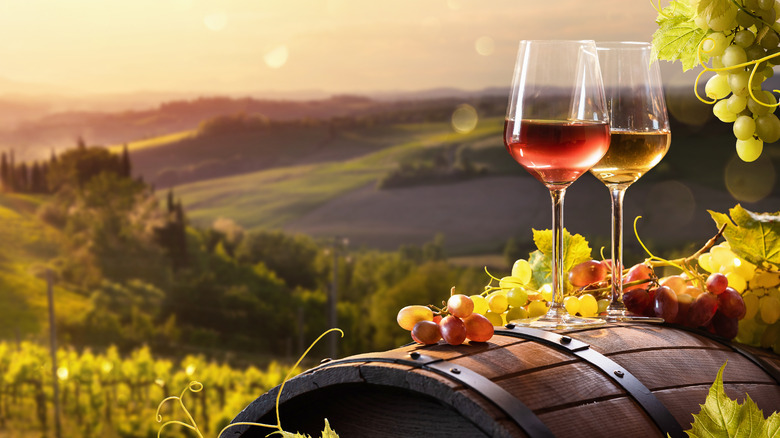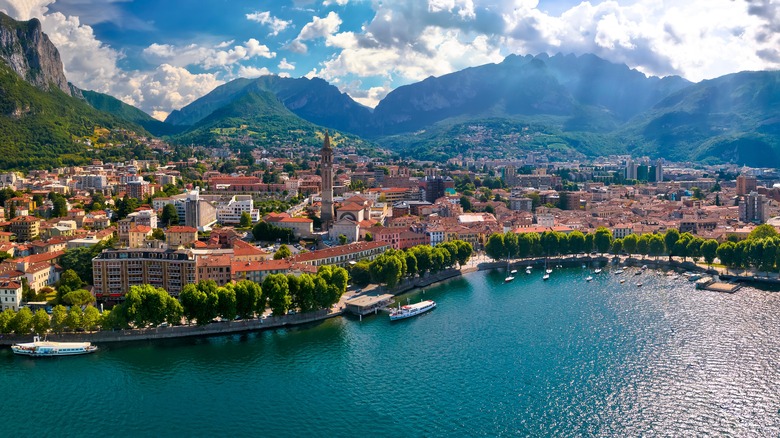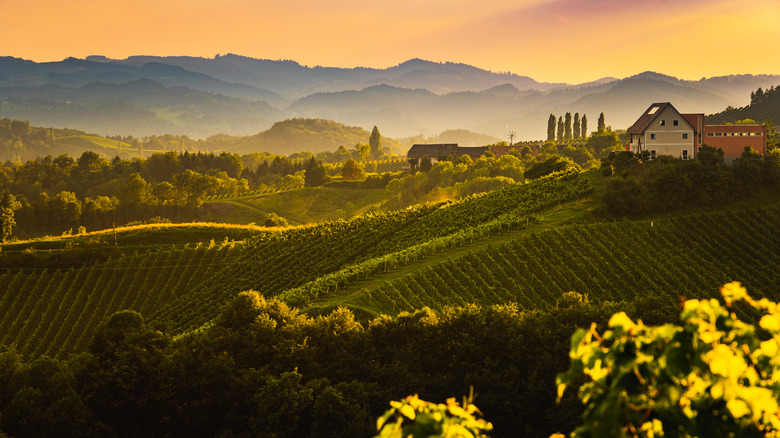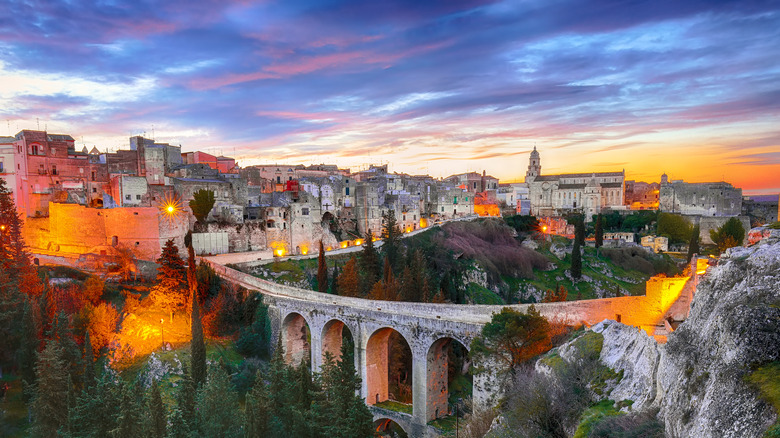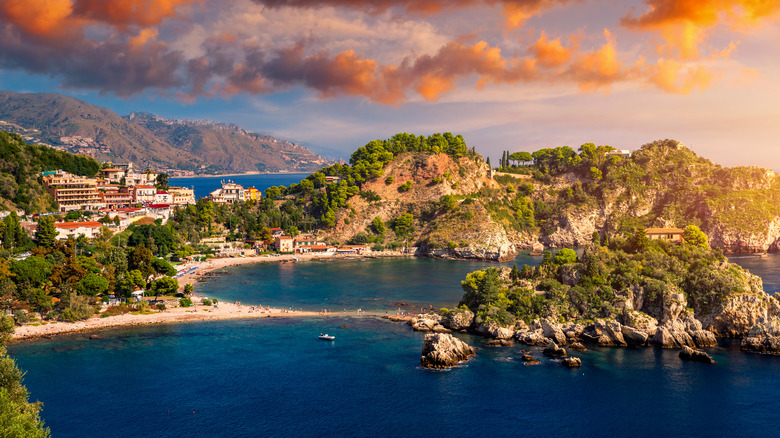How Italian Wine Differs By Geographical Region
The Italian peninsula is flanked by the Adriatic sea to the east, the Mediterranean sea to the south, the Ligurian and Tyrrhenian seas to the west, and borders France, Switzerland, and Austria, to the northwest, north, and northeast, respectively (per the De Long Wine Map of Italy). Italy is a small country, covering just 116,350 square miles, per Wandering Italy. By comparison, California is 163,707 square miles (via Netstate).
Almost 40 percent of Italy is covered by mountains and rolling hills, Wandering Italy reports. In the north, the mountains fan out from west to east, creating a natural border to the countries it abuts, and the country is bisected by a spine of mountain ranges that stretch from the north to the south (via the De Long Wine Map of Italy).
Wine has been produced in every region of Italy for hundreds if not thousands of years, and each region has its signature Italian grape varietals and style. Italian wine is coveted the world over for its character, diversity, and finesse.
Northern Italian wine regions
Northern Italy is dominated by the Maritime, Grainan, Lepontine, Rhaetian, Dolomite, and Carnic Alps and several vast and deep alpine lakes. The agricultural regions are tucked in between mountains and on hillsides around the lakes. From west to east, some of Italy's most famous northern wine regions are Piemonte, Liguria, Valle d'Aosta, Lombardia,Trentino-AltoAdige, Veneto, and Friuli-Venezia Giulia. Notable cities include Turin, Milan, and Venice (via the De Long Wine Map of Italy).
Generally, the wines from the northern wine regions are elegant with prominent acidity due to the elevation and broad diurnal shift, which is a scientific term for temperature fluctuations from day to night, reveals Cucina Toscana. Silky red wines with tangy berry, violets, and smoky notes — produced from the nebbiolo grape — dominate Piedmonte to the west. With rich and layered fruit and woodsy notes, Amarone and Valpolicella define the Veneto to the east. Near the northern border and in the north-central and northeastern mountains, winemakers craft crisp and bright white wines with racy acidity and grassy, citrus zest or saline notes like pinot grigio and Soave. There are also exceptional sparkling wines made in the traditional method, such as Champagne-esque Franciacorta and Trentodoc, and the fizzy sweet-tart Prosecco (per "The World Atlas of Wine").
The regions of Central Italy
The most famous Italian wines come from Central Italy. The plenteous region is comprised of the Tuscan-Emilian Apennines and Abruzzi Apennines running down the midsection that unfurls into rolling hills and plains stretching toward the coastal seas to the east and west. According to Cucina Toscana, the most famous central wine regions are Tuscany and Lazio in the west, and Emilia-Romagna, the Marche, Umbria, and Abruzzo to the east. Central Italy's most famous cities are Florence, Bologna, Siena, and Rome (per the De Long Wine Map of Italy).
Cucina Toscana reports that Central Italy is known for its robust sangiovese wines from Chianti Classico, Brunello di Montalcino, Bolgheri, and Vino Nobile di Montepulciano, along with perfumed and steely white wines from the trebbiano, vernaccia, and pecorino grapes, which are fruit-driven with notes of ripe stone fruit, citrus, and white flowers. Find amazing white wines in San Gimignano, Marche, Abruzzo, and Lazio. Elsewhere, Montepulciano d'Abruzzo is a fleshy red wine with ripe fruit and gritty earthy notes that hails from Abruzzo just below the Marche region along the Adriatic coast to the east. International varietals like Cabernet Franc, Cabernet Sauvignon, Syrah, and Merlot are also gaining in popularity in Central Italy (via "The Oxford Companion to Wine" and "Wine Folly: Magnum Edition").
Southern Italy's boot
The biggest city in Southern Italy is Naples. This is the region of Mount Vesuvius, Capri, the Amalfi Coast, and the Gulf of Taranto that divides the tip from the heel of the boot (per "DK Eyewitness Italy").
"The World Atlas of Wine" reports that Italy's southern wine regions are scattered across volcanic slopes rich with minerals that nourish the vines and orchards of the region. The regions are warmer, drier, and sunnier than those to the north. Molise and Puglia lie to the east, and Campania, Basilicata, and Calabria are to the west, north to south. The wines from this region are fleshy, ripe, inky, smoky, and tropical. Some of history's most storied wines — including Falerno and Aglianico — hail from the south, grown in the region for thousands of years; Aglianico is fabled to be the wine present at the Jerusalem crucifixion, according to 303 Magazine.
Full-bodied wines produced from red grapes such as Aglianico, Primitivo (Zinfandel), and Negroamaro are full-flavored, deeply colored, heady, and potent wines with notes of tar, smoke, blackberries, and black fruit; some wines will exhibit dried fruit and candied notes. The fragrant white wines like Falanghina, Greco di Tufo, and Fiano from the south are fruit-driven with bright acidity and lemony, pear, and saline notes when brown at higher elevations. However, when grown on the plains, they show tropical notes of pineapple, tangerine, mango, starfruit, and kiwi (per "WSET D3").
Italy's island wines
The Italian peninsula is surrounded by islands speckling the Adriatic, the Mediterranean sea, and the Ligurian and Tyrrhenian seas (via the De Long Wine Map of Italy). Three of those islands are known for their incredible contributions to Italian enology. The island wine regions produce refreshing whites, fruity rosés, and brazens from Nero d'Avola, Inzolia, and Cannonau, along with international varietals like Cabernet Franc, Merlot, and Chardonnay (via Wine Folly).
Wine Searcher reports that the tiny island of Pantelleria in the Mediterranean Sea produces a sweet white wine called Passito di Pantelleria — a distinct style of sweet white wine — along with a fortified wine called Passito Liquoroso from Muscat of Alexandria grapes, which are called Zibibbo on the Italian Islands.
Sicily is a large volcanic island just to the west of the toe-tip of the boot, and native grapes complement its seafood-drenched and spicy cuisine. White wines from the Inzolia and Grillo grape offer a cool, fruit respite with notes of melon, peaches, honeysuckle, mandarin, lime, lemon zest, and crunchy saline. Sicilian reds are bold, fruit-driven, and can be spicy with notes of chili flake, black cherry, juicy plum, licorice, and cola (via "Wine Folly: Magnum Edition").
Sardinia is just north of Sicily and is famous for its signature Cannonau grape, which is technically the same grape as French grenache and Spanish Garnacha. From Sardinia, it is herbal, rustic, and spicy, with blackberry bramble, raspberry, and leather notes. Sardinia also grows small plantings of Vermentino, producing a unique expression of the grape that is citrusy, with crisp green apple and floral notes (per "The World Atlas of Wine").
